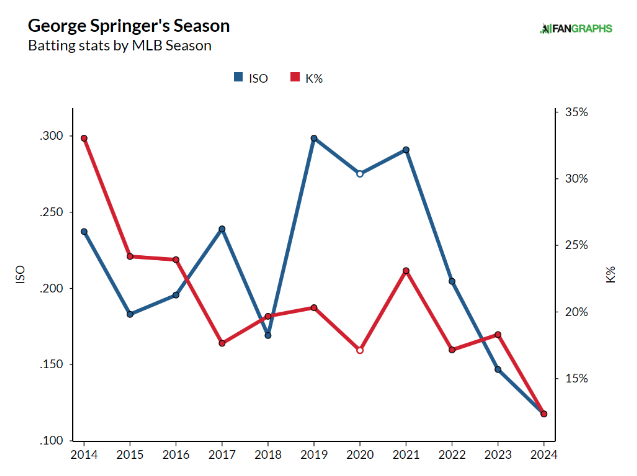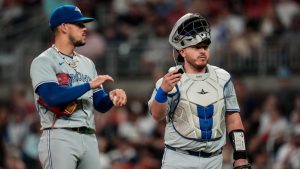TORONTO — The Toronto Blue Jays — as currently constructed — are not designed to bludgeon their opponents into submission.
Although that was clear entering the season, the team’s lack of power has been felt acutely in the early days of the 2024 campaign. Entering Wednesday night’s action, the Blue Jays rank 22nd in the majors in isolated slugging (.125) and 26th in home runs (14).
Toronto is compensating for those numbers slightly by running MLB’s third-best walk rate (11.1 per cent) and eighth-best strikeout rate (20.6 per cent), but the lack of thump is holding down an offence that has scored only 3.83 runs per game.
Every team has its warts, and the Blue Jays were expected to compensate for a relative lack of longballs with excellent pitching and defence in 2024. That’s what they’ve done in recent days, putting together a four-game winning streak in which they’ve conceded just eight runs.
That’s far from a sustainable run-suppression pace, though, and while the defence has generally been sound in 2024, the pitching hasn’t been as reliable. Even after stringing a few strong performances together in a row, Toronto has posted a 23rd-ranked 4.64 ERA — largely due to its MLB-worst 1.55 home runs per nine innings allowed.
Although the Blue Jays running out an offence built on contact and patience was expected, the club’s pitching staff being unable to keep the ball in the ballpark was not. Last season, the team posted a league average HR/9 (1.23) on the way to a strong season of keeping runs off the board.
The purpose of baseball is not to hit more home runs than your opponent, but it helps a great deal. Since the current post-season format was instituted in 2022, just 29.2 per cent of playoff teams were out-homered during the regular season. That includes the 2023 Blue Jays, but their home run differential (-10) was less damaging than what they have managed in just 18 games this season (-13).
Put another way, the Blue Jays are on pace to have their opponents hit 117 more home runs than they do. In the last two years, a playoff team’s worst number was minus-45 (Cleveland Guardians, 2022)
Any "on-pace-for" number can end up looking silly at this time of year, but this looks like a sizable issue for the Blue Jays. It will be tough to reach the post-season if their opponents have far more quick-strike offensive success than they do — and if they make it that far, home runs correlate with success in October as it's hard to execute methodical offensive rallies against elite pitching.
On the offensive side, there are a few opportunities for positive regression. The return of Danny Jansen — whose .493 SLG leads all Blue Jays since the beginning of the 2022 season — should be a great help. Bo Bichette, Daulton Varsho and Vladimir Guerrero Jr. project to hit home runs at a higher rate than they have, while Davis Schneider could help if he carves out more time.
At the same time, there’s plenty of personnel limitations. The second- and third-base smorgasbord featuring Cavan Biggio, Isiah Kiner-Falefa and Ernie Clement is low on pop. Justin Turner has been the least of Toronto’s problems overall, but there isn’t a single FanGraphs projection system that has him going over 16 home runs.
Kevin Kiermaier was aiming for more power in the spring, but the results have not carried over. George Springer seems to be focusing more and more on contact rather than power as each year passes.

Toronto’s best path to avoid getting routed in the home run battle is sorting things out from a pitching standpoint. Part of the issue the club has dealt with so far is a need to use pitchers it would prefer not to under different circumstances due to early-season injuries.
For instance, Bowden Francis, Wes Parsons and Paolo Espino gave up a combined eight home runs in 20.1 innings. Francis will have some role to play in the months to come, but it's likely to be in relief, where he should have better results than he did as a starter. Parsons has been traded, and Espino is not an arm the Blue Jays will call on if their staff is healthy.
Add in the fact Toronto has allowed the highest percentage of home runs on flyballs in the majors this season (16.8 per cent), and it feels safe to assume there’s been some bad luck too. For context, the next-highest HR/FB in the majors is the Minnesota Twins, at 14.9 per cent, and no team cleared 15 per cent in 2023.
There’s no guarantee the Blue Jays’ home-run avoidance will bounce back, but it seems like a solid bet — particularly if Kevin Gausman can get on track and they get some respectable production from the fifth-starter spot. Between Toronto’s durable veteran starters and relatively deep bullpen, the team is unlikely to remain in a position where its outfielders are constantly watching the ball clear the wall.
This Blue Jays team needs that to be the case, because its offence is short on reliable power sources.
Winning at the major-league level is not all about out-slugging your opposition, but if you are losing the home run battle by a massive margin, you’re in for an uphill battle. This team has turned that difficult situation into a 10-8 record, but its minus-15 run differential tells the story of a club that hasn’t found its formula for success yet.
That blueprint won’t boil down to one individual thing, but if the Blue Jays can’t get their home run deficit under control, a single factor could sink them.








COMMENTS
When submitting content, please abide by our submission guidelines, and avoid posting profanity, personal attacks or harassment. Should you violate our submissions guidelines, we reserve the right to remove your comments and block your account. Sportsnet reserves the right to close a story’s comment section at any time.